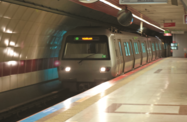Istanbul’s public transport system is set to be radically overhauled by the addition of an underwater transit tunnel, new train stations and a possible third bridge over the Bosphorus.
The most recent development in Turkey’s transport section has been the completion of the undersea section of the Bosphorus tunnel – or “Marmaray” – project. Widely expected to be operational by 2015, the tunnel will offer a commuter train connection between the Asian and European sides of Istanbul, which currently must be crossed either by ferry or the city’s two bridges.
With parts of the tunnel almost 200 feet underground, Marmaray is the deepest immersed tube tunnel in the world. Almost a dozen submerged prefabricated sections will span nearly 1.4 km across the Bosphorus Strait.
Once in operation, the commuter train will take passengers from Üsküdar on the Asian side of Istanbul to Yedikule station on the European side. Both of the stations are new developments, as are the stations being constructed at Yenikapı and Kazlıçeşme, which will offer stops further inland on the European side, bringing the total tunnel length to 13.5 km.
The trains, which will number 44 in total, are currently being manufactured in South Korea, although 10 have already arrived in Istanbul. At its full operating capacity, expected to be achieved by 2025, a 10-carriage train will depart every 90 seconds, carrying a maximum of 3000 passengers. This will allow the Marmaray rail to transport 75,000 people per hour, according to project estimates.
With parts of the Marmaray tunnel just 6 km from the active North Anatolian fault line, there is some worry that the project could be compromised by a quake, though project officials have said the tunnel will be strong enough to resist earthquakes measuring up to nine on the Richter Scale.
The project, which started in 2004 following five years of planning, is being funded by the Japan Bank for International Cooperation, which is providing an initial loan of $1.3bn. Due to delays, including work stoppages caused by the discovery of a 4th-century Byzantine port while excavating for the station at Yedikule, the project is now estimated to have run up a cost of $2.5bn.
The Turkish government is looking to the tunnel to help reduce pressure on Istanbul’s heavily congested roads. The Bosphorus Bridge, for example, was designed for a capacity of 100,000 motor vehicles per day when it was built in 1973; today, more than 250,000 vehicles cross the bridge every day.
However, under maintenance regulations, the Bosphorus Bridge is scheduled for renovation in 2015. The heavy repair work, which will include renewing the suspension cables, is expected to last one year, during which time some lanes of the bridge may be closed. This will leave the second bridge, Fatih Sultan Mehmet Bridge, to absorb some of the main bridge’s traffic. The government is hoping that the Marmaray tunnel will open in time to coincide with the repair of the bridge.
The government is also continuing with its plans to build a third bridge. According to the minister of transport, Binali Yıldırım, the proposed route – part of the 414-km North Marmara Highway project – will span the northern end of the Bosphorus between Garipçe, near Tarabya on the European side, and Poyrazköy, near Beykoz on the Asian side.
Despite the cancellation of the tender for the construction of the third bridge, which took place in January and failed to attract any bids, the tender will be re-launched on April 5. With the project time frame being narrowed to make the development more profitable, the government is confident a bidder from the private sector will come forward. What has changed about the financing package to make the project more attractive to contractors?
“The highway department issued a revised tender on February 1 with a short bidding deadline of April 5, which is making it more difficult for players to prepare, particularly international firms,” Mehmet Ali Neyzi, the CEO of STFA, a Turkish construction company based in Istanbul, told OBG. “However, the highway department has made it clear that they want to finish the project in three years. The new tender has several incentives for bidders and makes development more viable.”
Plans for a third bridge, however, have prompted much controversy. The $5bn project has drawn a range of criticisms, including environmental concerns that large sections of forested areas north of Istanbul would need to be cleared away, which would go against a $50m three-year master plan implemented to contain the city’s borders from intruding into the northern forests. There are also concerns that a third bridge will merely add to the city’s traffic problem, rather than alleviate it.
The government has indicated that it would be prepared to go it alone and fund the project with public funds if no bidder comes forward at the April tender.
With Istanbul’s population at some 13m and growing annually, the government’s focus on transport projects is well timed. Moving forward, this should provide outside investors with ample opportunities to help lay the groundwork to get people and commerce moving.
*Photo courtesy of William Zeman

